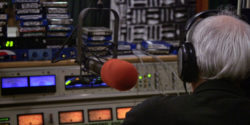Musician, DJ and radio artist Don Joyce passed away nearly three years ago, on July 22, 2015. He left behind a voluminous archive of his KPFA radio program “Over the Edge,” which took off in new, chaotic and creative directions when he welcomed the participation of the experimental band Negativland in 1981, then joining the group.
The documentary “How Radio Isn’t Done” sheds light on Joyce and his life, work and his process for recontextualizing the never-ending flow of media messages that flood everyday life. Director Ryan Worsley paints an affectionate, but honest portrait of a man who poured tremendous quantities of inspiration, energy and effort into his community radio program, leaving the impression that it was something he just had to do.
How Radio Isn't Done from Ryan Worsley on Vimeo.
In the film Joyce walks through his workflow of recording audio, from sources like broadcast television, onto audiocassettes, then isolating segments and dubbing those onto a second cassette. To make these snippets ready for on-air manipulation, he then dubs them onto broadcast carts, tape loop cartridges, similar to 8-track tapes, that were used in radio broadcasting from the 1960s through to the 1990s. Of course, Joyce continued to employ this analog technology to the very end, because: why mess with success?
Yet, we also see that towards the end of his life, Joyce began retreating inward, no longer wanting to tour or perform live with Negativland, to the obvious concern of his bandmates, who could see his decline. They reflect on Joyce’s quirks, brilliance and fallible humanity like the old, loving friends that they are.
After Joyce’s passing his bandmates take on the responsibility of digitizing his massive store of sound fragments, as well as the thirty-four year archives of “Over the Edge.” We look on as they package baggies of his ashes in with copies of the last album he worked on, “The Chopping Channel,” all to be shipped to fans.
Radio broadcasting can be a paradoxically lonely pursuit. While DJs transmit their voice and other sounds to hundreds, thousands or millions of listeners, they’re often alone in the studio, or surrounded by just a few colleagues and collaborators. While the phone may ring–and Joyce eagerly mixed callers into the broadcast feed–the communication with the audience is rarely a true conversation.
That an esoteric artist like Joyce could find a small community of collaborators and an audience for his work is a testimony to the power of radio, especially non-commercial college and community radio where boundaries may be pushed and heterodoxy disposed. The price is that your art may go barely noticed.
Though far from famous, Joyce’s work was noticed by people who could appreciate it. And while at times he does come across as a slightly tragic figure, watching “How Radio Isn’t Done,” I wonder what else he would have done that would have made him happier or more satisfied.
Having spent thousands of hours in community and college radio stations, this is a familiar archetype: the person whose radio show provides the necessary meaning for their life, whether one or a million people are tuned in.
I believe that most human beings have a desire to create, to be productive. I place no qualification on what that means, whether it’s building models, cooking meals, perfecting a golf swing or coloring pictures. “How Radio Isn’t Done” is a portrait of someone who had to create a radical form of radio, and in so doing left behind an artistic legacy of collage, recontextualization and culture jamming (the latter a term he coined as his on-air character “Crosley Bendix”) that has had inestimable impact on our media culture at large.
“How Radio Isn’t Done” is available on for viewing on demand on Amazon and Vimeo.



